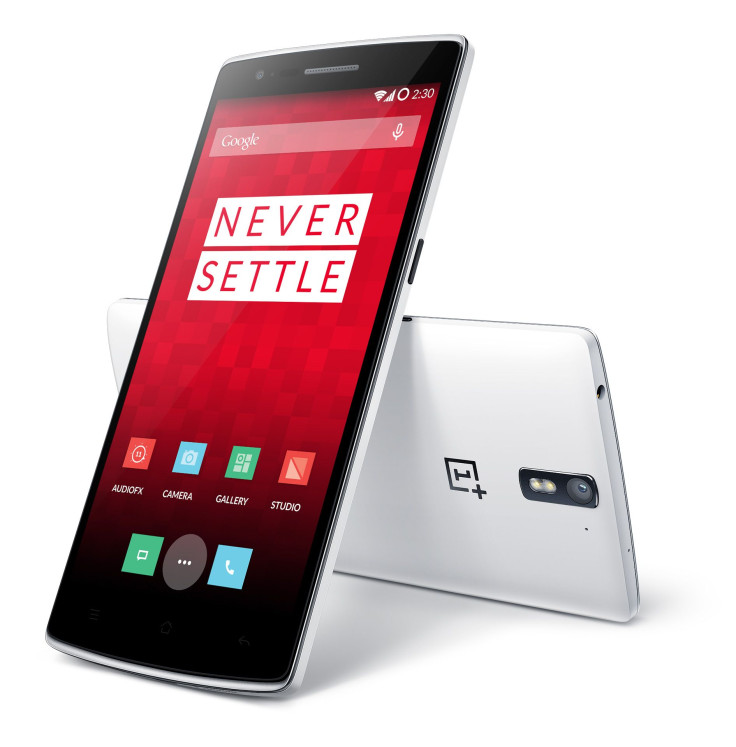Meet OnePlus: The Best Chinese Smartphone You Can Buy, If You Have An Invite

How does an unknown Chinese handset maker create a Samsung-killing smartphone for American consumers? Stuff it with the latest advanced technology, price it for hundreds below the average high-end cost, and make it extremely challenging to purchase.
That’s the improbable recipe being followed by Chinese manufacturer OnePlus, which is now widening the availability of its handset with an online sale every Tuesday. Otherwise, those interested in getting their hands on the smartphone will have to go through the usual channel, acquiring an invite via an existing OnePlus One owner or contests conducted by OnePlus.
OnePlus was founded by Pete Lau, a former executive with Oppo Electronics, in December 2013, with the aim of creating his notion of the perfect smartphone. That realization came to life when the OnePlus One launched in April 2014. Since then, the device has garnered a cult following and rave reviews, adhering to the company motto, “Never Settle.”
Early Marketing Fumbles
OnePlus has sold nearly 1 million handsets since then in its unusual manner, but the company has not been without its controversies. Some marketing fumbles included its “Smash the Past” campaign, which was criticized as hazardous and wasteful by having people submit photographs of themselves destroying their old phones to win OnePlus One handsets. Its “Ladies First” campaign also drew fire as being sexist in having female fans submit their photos for votes in an effort to win OnePlus One invites.
Since the launch of the OnePlus One, however, the Chinese brand also has dispelled any doubts it could sell phones in Western markets by having demand crash its website when the handset became available in the U.S. -- and by growing the number of members on its support forums to more than 400,000 from 5,000.
OnePlus positions itself as offering a higher-quality product than Chinese competitors such as Xiaomi Inc., which also offers devices for a fraction of the standard premium price, but moves considerably more handsets than OnePlus. In comparison, the 4-year-old Xiaomi sold 61 million handsets in 2014 and has become market competition for the likes of Samsung Electronics Co. Ltd. and even Apple Inc. But Lau said OnePlus has no intention of sacrificing device quality for the sake of selling more phones faster. And unlike Xiaomi and another Chinse rival, Huawei Technology Co. Ltd., OnePlus is actually selling phones in the U.S.
Its invitation system serves two purposes: one is to create the perception of scarcity and the other is to ensure OnePlus only manufactures phones it can sell. “Sooner or later, it’s going to stop, and we don’t want to be caught with too much inventory,” OnePlus co-founder Carl Pei told PC Magazine in November. “With no margins, we can’t have a situation where we have too many units and we’ll have to discount them. For us, the first year was about survival.”
Lessons From Google
The 32 GB OnePlus One sells for $299 unlocked, while the 64 GB OnePlus One sells for $349, reminiscent of old prices for Google’s Nexus brand smartphones. Lau told the Verge in December 2013 that OnePlus took advantage of lessons learned by Google in how to successfully sell a phone online. While Google has begun offering its Nexus smartphones at most major carriers, the OnePlus One continues to be sold exclusively online.
The OnePlus One has hardware specifications comparable with other high-end devices sold in 2014, such as the Nexus 5 and Samsung Galaxy S5. It features a Qualcomm Snapdragon 801 chip, a 5.5-inch full high-definition display, 3 GB of random-access memory, 16 GB or 64 GB internal storage options, a 13-megapixel rear camera, a 5-megapixel front camera and a 3100 milli-ampere hour battery. The OnePlus also runs the custom Android-based CyanogenMod 11S. In India, the OnePlus One will run the company’s own Oxygen OS. It’s a system it developed in response to a conflict with Indian telecommunications company Micromax, whose YU brand of smartphones has the rights to the CyanogenMod OS exclusively in South Asia.
With that conflict behind them and Oxygen OS set to launch Feb.12, OnePlus is now focusing on appeasing consumer demand for easier access to the OnePlus One. Customers will be able to purchase the devices without invites every Tuesday for 24 hours, beginning at 12 a.m. PST (3 a.m. EST). Even Indian fans will be able to purchase the devices via Amazon.in (the OnePlus One had previously been banned in the country).
The Next OnePlus Phone
The OnePlus One will have a sibling in 2015. Likely called the OnePlus Two, it is expected to launch around June. Whether it is released in the late second quarter or the early third quarter, it could have more of a focus on design, Pei indicated. The device should have updated specifications and a slightly higher price tag. However, the OnePlus One will maintain its original price.
Learning from its first year of business, OnePlus has a number of key goals set in place for the launch of its next phone, including streamlining its operations and adopting better customer-service practices. “This period that we have now is a very good time for us to become a lot more professional,” Pei told PC World in January.
© Copyright IBTimes 2025. All rights reserved.





















